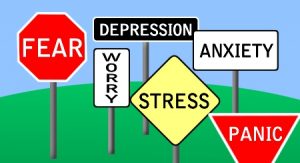Description of the Sample
This analysis includes all patients with a primary diagnosis of a mood disorder who participated in an evaluation followed by a minimum of one therapy session with me between the start of my practice in 2009 and spring 2017. Given that this is an analysis of end of treatment outcomes, patients who are currently in treatment with me were not included in this sample.
The sample includes 34 individuals (29 females and 5 males) who ranged in age from 12 – 59 years old, with a median age of 20. The majority of patients in this sample (65%) had a primary diagnosis of Major Depressive Disorder. Other primary diagnoses included Unspecified Depressive Disorder, Bipolar Disorder, Mood Disorder Not Otherwise Specified, and Persistent Depressive Disorder (formerly known as Dysthymia).
More than half of these patients (56%) had a secondary diagnosis. The most common secondary diagnoses were anxiety disorders. Other secondary diagnoses in this sample included ADHD, eating disorders, and PTSD.
Approximately 30% of the sample had a history of psychiatric hospitalization, most commonly for suicide attempts or suicidal ideation, prior to staring treatment with me.
Description of Treatment Received
The length of treatment varied dramatically, from one week to 3.7 years. Number of sessions attended also varied dramatically, from 1 session to 135 sessions. The broad range of treatment duration and sessions attended reflects the reality that some individuals decided not to proceed with treatment after one or two sessions, whereas other individuals attended sessions off and on, as needed, for the duration of their high school or college years. The average duration of treatment was 11.9 months and the average number of sessions attended was 28. So, a typical patient with a mood disorder attended approximately 28 sessions over the course of one year.
The type of treatment received was tailored to the individual patient, based on his or her presenting symptoms, circumstances, age, and preferences. Forty-one percent of patients received Cognitive-Behavioral Therapy (CBT), 18% received a Dialectical Behavior Therapy (DBT) skills-based approach (NOT a comprehensive DBT program), 30% received integration of CBT and supportive counseling, and 11% interpersonal psychotherapy or supportive counseling.
Level of family involvement varied depending on the patient’s age, presenting symptoms, preferences, and living circumstances. For the purposes of this assessment, high level of family involvement means that at least one family member attended all or most sessions with the patient. Moderate level of family involvement means that family members attended some sessions and maintained ongoing communication with me throughout treatment. Low level of family involvement means that at a family member was involved in the evaluation and/or at least one session, but most sessions were individual. Among all patients in this sample, 18% had a high level of family involvement, 21% had a moderate level of family involvement, 18% had a low level of family involvement, and 44% had no family involvement. Degree of family involvement was higher, in general, for adolescent patients than for adult patients, with all patients under age 18 having at least some family involvement in their treatment. Fifty percent of adolescent patients (under age 18) had a high level of family involvement, while 42% had a moderate level of family involvement and the remaining 8% had a low level of family involvement.
Nearly ¾ of patients saw a psychiatrist and took psychotropic medications during treatment. Nearly ¼ of patients were hospitalized during treatment, most commonly for suicidal ideation or suicidal gestures.

Treatment Completion and Recovery Rates
Of all patients who began treatment with me for a mood disorder, 15% achieved complete recovery, 24% made significant progress, 41% made some progress, 15% made no progress, and 6% regressed. For a detailed description of what terms such as “complete recovery” and “significant progress” mean, please see this blog post from 2013.
Eighteen percent of patients completed a full course of treatment with me. Completing a “full course of treatment” was defined as a mutual ending in which the patient, his/her family (in cases where family was involved) and I mutually agree that treatment goals have been met and treatment is no longer needed. Of these “treatment completers,” 83% achieved full recovery and the remaining 17% made significant progress towards treatment goals.
The length of time required to complete a full course of treatment varied dramatically from person to person, depending on symptom severity and progress in treatment. Time required to complete treatment ranged from 1 month to 3 years, with a mean of 16.6 months. Likewise, number of sessions required to complete treatment varied dramatically between individuals. Number of sessions attended for treatment completers ranged from 4 – 96 sessions, with an average of 23 sessions. So, on average, individuals who were most successful in treatment (e.g., those who completed treatment and achieved full remission from their mood disorders) attended an average of 23 sessions over the course of 16 months.
Fifteen percent of patients moved to another geographic location during their treatment (either to attend college or to live elsewhere permanently), prior to completing a full course of treatment with me. As of their last session with me, 60% of these “movers” had made significant progress in their treatment and the remaining 40% had made some progress. These individuals were referred to other treatment providers in near their universities or new homes for continued treatment.
The dropout rate for patients with mood disorders was fairly high: 50% of patients discontinued treatment with me prematurely. As of their last session with me, 18% of these “discontinuers” had made significant progress towards treatment goals, 59% had made some progress, and 24% had made no progress. On average, individuals who discontinued treatment sooner made less progress, while those who remained in treatment longer made more progress towards their treatment goals. Three quarters of the individuals who made no progress dropped out of treatment after just one or two sessions, and the remaining one quarter dropped out after 5 sessions. In contrast, those who made significant progress prior to dropping out of treatment attended an average of 20 sessions.
I do not have data on what happens to patients after they discontinue treatment, so this is purely speculation, but I believe several factors contribute to the high dropout rate among patients with mood disorders. First, depression frequently interferes with a person’s motivation and ability to carry out tasks, and tends to make people hopeless and pessimistic. Individuals with these symptoms may have a more difficult time persisting towards a goal, such as scheduling appointments and continuing with treatment over a number of months, and they may feel less hopeful about having a positive outcome in treatment. Second, some patients and families may be satisfied with “good enough,” and may drop out of treatment after making good progress but before achieving all treatment goals. In contrast, I have high standards for my patients: I believe that full recovery is possible for most people, and when full recovery does not seem achievable, then a full and meaningful life with well-managed symptoms is an alternative good outcome. I work diligently with patients and their families in pursuit of these goals.
Eighteen percent of patients with mood disorders were referred to other clinicians who could better meet their needs. I made these referrals when a patient was not progressing in treatment, and when it did not appear likely that they would make progress in the near future. As of their last session with me, 17% of referred patients had made significant progress, 33% had made some progress, 17% had made no progress, and 33% had regressed.
Predictors of Treatment Outcome
Not surprisingly, completion of a full course of treatment emerged as a strong predictor of positive treatment outcome. 83% of individuals who completed treatment achieved full recovery, while the remaining 17% made significant progress towards treatment goals. None of the individuals who discontinued treatment prematurely achieved full recovery.
Another strong predictor of positive treatment outcome in this sample was referral source. Eighty percent of individuals who achieved full recovery were self-referred (e.g., they found my practice through an online search), while the remaining 20% were referred by word of mouth (e.g., by a friend). In contrast, none of the individuals who were referred to my practice by their psychiatrist, pediatrician, or another therapist completed a full course of treatment or achieved full recovery, although a number of them made significant progress. My interpretation of this finding is that individuals who proactively sought my services of their own volition may be especially dedicated to improving their mental health, more invested in their treatment, and thus more likely to persevere through a full course of treatment and achieve recovery. In the case of self-referred adolescents, their parents were the ones who actually brought their children to treatment. These parents, on the whole, were particularly attuned to their child’s needs and struggles, researched their child’s symptoms and the variety of treatment approaches available, sought my services proactively, and were especially motivated to help their child recover. Perhaps this parental conscientiousness, attunement, and empowerment helped facilitate recovery for their children.
Level of family involvement in treatment predicted treatment completion and full recovery for adolescent patients but not for adult patients. All of the adolescents who completed treatment and recovered had moderate or high levels of family involvement. In contrast, 75% of the adults who completed treatment and achieved full recovery had no family involvement in their treatment, while the remaining 25% had a low level of family involvement.
Individuals who took psychotropic medication were somewhat less likely to recover than those who did not: 40% of individuals who achieved full recovery were taking medication during treatment, whereas 76% of individuals who did not achieve full recovery were taking medication during treatment. It is unlikely that taking psychotropic medication caused patients to have a worse outcome. I believe the most likely explanation for this finding is that taking psychotropic medication is a marker of severity: individuals with more severe forms of mood disorders (e.g., Bipolar Disorder, Severe Recurrent Major Depressive Disorder) are more likely to need medication and are perhaps less likely to achieve complete remission of symptoms.
Hospitalization during treatment emerged as a predictor of less favorable outcome. None of the individuals who were hospitalized during their treatment with me completed a full course of treatment or achieved full recovery. It is unlikely that being hospitalized actually caused patients to quit treatment or caused them to make less progress in their treatment. It is more likely that hospitalization, like taking psychotropic medication, is a marker of severity, and those individuals with more severe illnesses are less likely to experience complete remission of symptoms.
The following variables did NOT predict treatment outcome: age, gender, ethnicity, duration of illness, diagnosis, presence of co-morbid diagnoses, rate paid for services, type of treatment received, or history of hospitalization prior to starting treatment.








